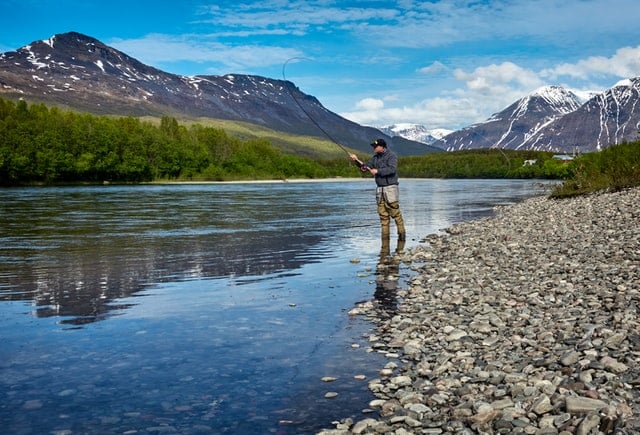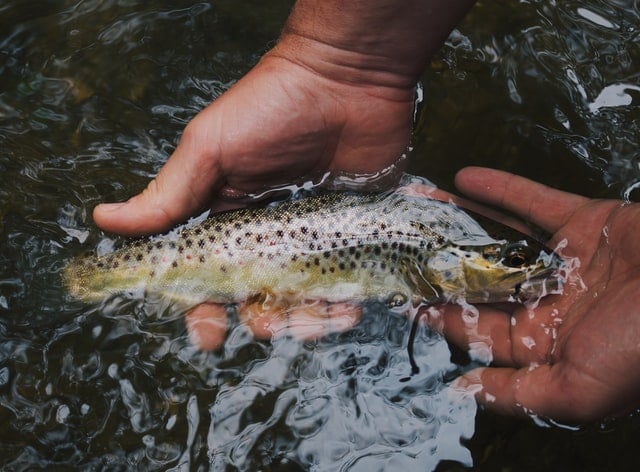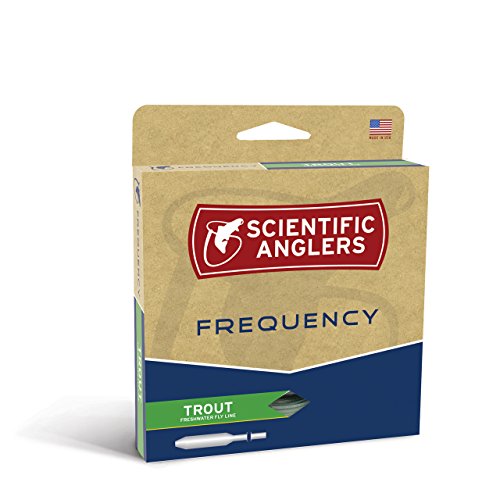Fly fishing is one of the most difficult but rewarding types of fishing around the world. It’s so difficult because of the high level of skill regarding techniques as well as the more technical equipment required for the practice. One of the most difficult but important aspects to consider about fly fishing is the type of line that you’re using, and floating fly line is one of the most common types used. This guide runs through a few of the best floating fly lines on the market while also providing you with helpful information to utilize during your buying process.
Best Budget Choice
#3 Orvis Clearwater WF
- 3-9 Weight
- Compact head
- Built half a size heavier
Best Pick
#1 3M Ultra Perfomance
- 5 Weight
- Moss-Grey-Gold
- 90’ length
Best Premium Choice
#5 Airflo SuperFlo
- 3 Weight
- Heron Grey/Golden Stone
- 100% PVC free
Table of Contents
Best Fly Line Reviews
1. RIO Products InTouch-Rio Gold Wf5f Moss-Gray-Gold Fly Line (Best Freshwater)
Features:
- 5 weight
- Moss-Grey-Gold
- 90’ length
- Freshwater
The RIO Products Intouch-Rio Gold Wf5f features a special taper design that will give you great loop stability at practically any casting distance. The line itself features a non-stretch quality that can help to enhance your ability to detect any sudden movements in the water. And the long head is great for fishermen that plan to fish in the river.
It’s classified as the best overall freshwater floating fly line because of its long head, ultra-low stretch connector and the special taper design. It does tend to be a bit more expensive than some other types of fly lines on the market, like the Orvis Clearwater fly line or the RIO Avid line. But the improved sensitivity and high-quality design may be worth the extra money.
2. Scientific Anglers Frequency All-Around Floating Trout Line (Best Allround)
Features:
- 3 weight
- Buckskin color
- 90’ length
Classified as the best all-round floating fly line on the market, this Scientific Anglers floating trout line is perfectly designed for trout fishing in river waters. It features a mid-length head in addition to a braided multifilament core that caters to the line’s performance and usability. Even more, there’s a welded loop for more secure connections, further improving the durability of the line.
As for the taper, it features a versatile design that can be used with a range of rods and for catching various types of fish. The three weight properties may not be suitable for all types of rods and brands on the market, but the floating line’s Advanced Shooting Technology makes it better than other competing fly lines in the industry.
3. Orvis Clearwater WF Fly Fishing Line (Budget Pick)
Features:
- 3-9 weight
- Compact head
- Built half a size heavier
If you’re looking for a high-quality floating fly line for Clearwater purposes, then you may want to consider using this Orvis WF Fly Fishing Line. It’s built heavier overall than other types of line on the market, making it easier to assemble onto the rod. It also has a convenient compact head that can make for a positive leader turnover.
It’s specifically built with integrated slickness that reduces the overall amount of friction that you feel. Lastly, this Orvis Clearwater Fly Fishing Line features a braided multifilament core that offers a pristine performance. Previous customers say that the line doesn’t seem to last as long as some of the other products over time, but the more affordable price makes this floating fly line worth it.
4. RIO Avid Trout WF Fly Line (Best for Trout)
Features:
- 3 weight
- Pale yellow
- 80’ length
For those of you interested in fly fishing for trout, you may benefit the most from the RIO Avid fly line. It’s produced with a versatile taper design that can help for easy casting, which is especially great for beginners. Also catering to the casting performance is the incredibly slick design of the line.
As for distance, this fly line from RIO comes with AgentX technology that increases the overall amount of distance you can cast the line out. Finally, this floating fly line has a welded loop only in the front end to help make rigging the line easier. The line does only measure 80 feet, which is a bit smaller than some other lines on this list, but the overall heavier design of the fly line makes up for this loss in length.
5. Airflo SuperFlo River and Stream (Best Taper Profile)
Features:
- 3 weight
- Heron Grey/Golden Stone
- 100% PVC free
Specifically designed with a versatile and high-quality taper profile, the Airflo SuperFlo River and Stream fly line can be used for practically any type of fishing purposes. Not only is it capable of being used in rivers and streams, but it can easily catch a variety of fish species, including trout, salmon, grayling, steelhead, panfish and even carp.
The taper is long, delicate and located on the front portion of the line, allowing you to gently land flies for both longer and shorter casts. The welded front loop design offers security, and the heron gray/golden stone colors make the line easy for you to see in the water while remaining invisible to fish. The Airflo SuperFlo River and Stream fly line may be a bit more expensive than some of the other floating line options on the market, but the overall high-quality and optimal performance may be worth it for you.
How Do I Choose a Floating Fly Line?
Casting Distance
The casting distance of a fly line refers to the distance that the line can be cast, and this will ultimately differ according to the line’s weight, length, the overall design of the line as well as the type of rod that you’re using. Most fly lines should have the ability to cast at least 50 feet comfortably, but this may differ according to your personal preferences.
You should consider purchasing a floating fly line that’s capable of casting to the specific distance that you feel comfortable casting. For beginners, this may be shorter distances. But the line’s capability differs according to the different products on the market.
Durability
The durability of a line is determined by the type of material the line is made out of as well as its design, the brand and some other factors as well. Typically, the more durable fly lines feature a braided multifilament core that can help to reduce the line’s risk of breaking when you either catch a larger fish or get snagged.
Aside from the material in the core, the fly line’s durability is also determined by the coating that’s been applied over top of the core. This coating will affect not only the performance of the line, but it also determines how long the fly line will likely last. Most coatings are made either from PVC or polyethene material. Both types of coating materials help to make the fly line more durable.

Where are you fishing?
It’s important to consider where you’re fishing before you choose a certain floating fly line because the types of waters you’re practicing in can drastically affect the line’s performance. Certain fly lines are better for specific water conditions, and the line’s performance In water ultimately depends on its weight and buoyancy.
All floating fly lines should have optimal buoyancy, but the weight of the line differs for many floating fly lines, increasing the importance of your becoming familiar with which types of waters are best for your line and other fly fishing equipment.
What species are you looking to catch?
Other than the specific locations that you’re planning on fly fishing, you should also consider what types of fish you’re looking to catch. This can help you to choose the best overall floating fly line because you can better determine the line weight that’s best for catching your target fish.
Certain floating fly lines usually list the types of fish that they can work best within their product descriptions, so you may benefit from searching for this information. Most floating fly lines are capable of working with salmon, panfish, trout and many others.

Type of Rod You Have
It’s important that you consider what type of rod you have because some lines perform better when they’re paired with certain types of fishing rods. You don’t want a fly line that’s too large for your rod because this will drastically decrease the performance of the line and can even result in your having less success while fly fishing.
There are many different types of rods and reel on the market, but fiberglass or fast action rods seem to be the most prevalent. Both types of rods are built for specific purposes, so it’s up to your personal preference which one you choose to use. But you’ll need to make sure that you match the fly line weight rating to the weight rating of the fishing rod regardless.
Matching Fly Line Weight Rating to Weight Rating of Fishing Rod
Different fishing rods have the ability to support certain weight ratings, so you need to choose the right floating fly line to match the weight rating of your rod in particular. With fiberglass rods, you’re required to match the weights of the line and rod or you’ll end up with a poor setup that decreases your overall performance.
On the other hand, fast action rods are a bit more lenient with the weights matching. Many anglers tend to over-line their rods as they become more experienced, since this can allow for new techniques while fly fishing. For instance, fast action rods that are over-lined have the ability to deliver tighter and more precise loops.
Tapers
Tapers essentially refer to an adjustment to the fly line itself that can affect how the line is weighted. There are different profiles that can result in differing performances and techniques. Ultimately, the taper makes the line get thicker or thinner in certain areas. The thinner tapers help to reduce friction and have an overall better fly fishing performance.
Taper profile
The taper profile is ultimately just the design of the taper overall. The taper profile is where the thicker or thinner parts of the line are located. From that, there are two major taper profiles, weight-forward and double tapers. Weight-forward lines have compact, shooting heads that are weighted. Following the thicker front portion of the line is a thinner part that experiences less friction after you shoot the head from your rod.
On the other hand, double taper refers to lines that are symmetrical on both sides with tapers on both ends. Usually, dry fly anglers utilize these types of lines because the energy of the weight is transferred equally. Floating lines have a weight-forward design because the thicker taper in the front part of the line can more easily float on the water’s surface (1).
Taper length
You’ll also want to think about the length of the taper in addition to the taper profile. The taper length directly affects how your fly lands on the water. More specifically, long tapers typically have a more delicate landing, and short tapers have a more aggressive landing.
It’s important that you consider the right kind of taper length for your specific fishing purposes because it will directly affect the types of fish that you’re planning on catching. For instance, those of you fishing for trout will likely want a longer taper, while those that want to catch carp or salmon will likely want a taper shorter in length.

FAQs
What is the best fly line for beginners?
Beginners to the fly fishing industry will want a floating fly line that’s easier to control and highly durable and slick. That being said, most beginners will benefit the most from the RIO Avid Trout WF Fly Line. It’s extremely easy to cast, can be used for all purposes, and is slick.
What is the best fly line weight for trout?
You’ll most likely want a fly line with a weight of between four to six if you’re planning on catching trout.
Final Thoughts
Overall, fly fishing can be one of the most entertaining types of fishing out there. Once you gain access to the right kind of equipment and have knowledge about the skills and techniques required, you could spice up your fishing game. Floating line is one of the most common types of line for fly fishing because of the many benefits it comes with. But choosing the right kind of floating line can be a difficult process.
After reviewing this guide, you should have been able to gain a better understanding of what the best kind of floating line would be for you. I hope that you can have better confidence in purchasing the right floating line product from the list for your particular instances, and if you’ve found this article helpful then you’re welcome to share for others to see.















